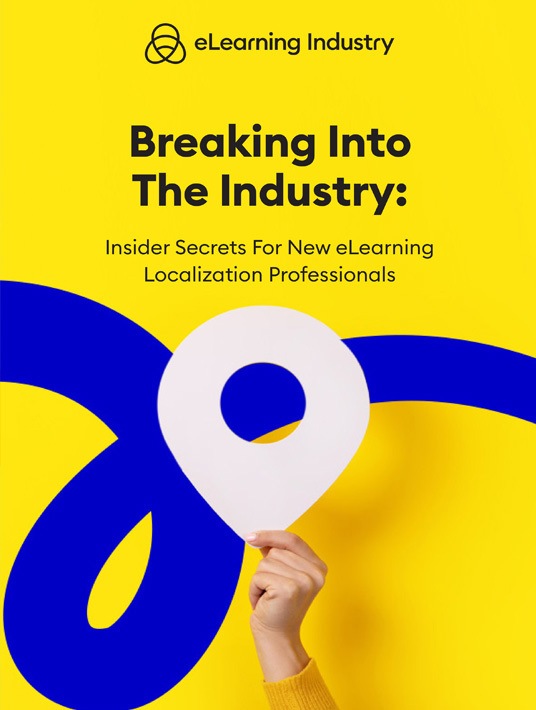Your Guide To Breaking Into The eLearning Localization Industry
Localization professionals have even bigger opportunities due to the COVID crisis, as more companies move their training online. They're looking for ways to globalize L&D initiatives and connect with their remote workforce. However, breaking into the industry can be daunting. Where do you even begin? How do you launch your new business? Which types of content are part of the localization package? This guide answers all of your most pressing questions so that you can embark on your new career path with greater confidence. First, let's dive into the basics of what the eLearning localization industry is and why organizations invest in localization to boost employee engagement.

What's Inside This Guide...
- What Is eLearning Localization?
- Why Do Organizations Localize Online Training?
- 6 Types Of eLearning Content That Are Localized
- 5 Common Online Training Localization Myths
- 5 eLearning Translation Best Practices
- How To Start Your Own eLearning Localization Consultancy Business
- 5 Tips To Promote Your Localization Services
1. What Is eLearning Localization?
Localization is the process of converting content into something that's suitable for the target audience. While their geographical location is a factor, societal norms and beliefs are also important considerations. This could be anything from translating a module to developing a simulation that includes cultural references and feels authentic for the online learner.
The main goal is to facilitate knowledge transfer and retention. However, it's also a matter of connecting with your audience on a personal level. They're more likely to absorb the key takeaways if content ties into their job duties, gaps, roles, and backgrounds.
A prime example of this is adapting content for new hires in another country. You need to instill the brand values and beliefs, but you must also take their expectations and experiences into consideration. It's not simply a matter of translating courses into their native language. Ultimately, you must provide them with meaningful and relatable eLearning resources that prompt them to reflect on their own performance and behaviors.
2. Why Do Organizations Localize Online Training?
There are a variety of reasons why businesses decide to localize their training (and bring a localization pro on board). It's essential for those just breaking into the industry to understand use cases, as this will help you hone relevant skills and fine-tune your marketing approach. Here are just a few reasons to keep in mind when launching your new eLearning localization biz:
Expand Into New Markets
Most organizations have plans to venture into the global market at some point. After all, it's a natural progression. But, they need online training content that connects with their new target audience (AKA new hires in new locales). Thus, they hire localization professionals to help them create culturally relevant resources and bridge knowledge gaps quickly. For instance, a company may enlist your services to convert their skills-based certification training course for new international sales teams or external partners.
Improve Employee Engagement
Employees must be fully immersed in the eLearning experience to improve performance behaviors and retain key takeaways. As such, many organizations hire localization companies to boost engagement and participation. For example, they convert demo videos or branching scenarios so that staffers form an emotional connection. In short, learners fully comprehend the subject matter because it's in their native language and features cultural references they're already familiar with.
Increase Knowledge Retention And Recall
Online learners can assimilate the information more effectively instead of trying to decipher a foreign language or missing out on societal references. They also retain more information because it touches on all the essentials they need to know instead of trying to cover too much ground. In many respects, the eLearning localization industry is about personalization. Employees are able to focus on topics, skills, and tasks that pertain to their job duties because it's custom-tailored to their L&D needs.
Maintain Brand Consistency
Hiring a localization professional allows organizations to develop online training experiences that are consistent with their brand image and messaging. For instance, the compliance regulations may differ based on geographical locations. However, the resources still align with their core values and mission statement. In other words, nothing was lost in translation (pun intended) and everyone receives the same eLearning benefits.
3. 6 Types Of eLearning Content That Are Localized
Just as there are different occasions (or pain points) that prompt organizations to hire a localization pro, there are numerous types of eLearning content you may be asked to adapt. Of course, it's your prerogative to limit your offerings and specialize in certain delivery formats. That said, including more content in your services menu helps expand your reach and gain even more on-the-job experience.
Video Demos
There's typically more than one way to localize video demos. The most common approach is to add subtitles or closed captions. However, many organizations opt for fully translated productions, or even reshoots with local actors and/or fresh animations. Bear in mind that this typically calls for a bigger budget and video production software, which you'll need to factor into your client estimates. On the other hand, subtitling is often the best strategy if you want to support learners with special needs; for instance, employees who are hearing impaired.
Interactive Guides
This may be in the form of eBooks or slide shows that are, generally, more text-heavy. For instance, the client may have an onboarding PDF they need to localize for their new recruits in Europe. The challenge that many localization pros face with this type of content is compliance, as many interactive guides focus on policies and protocols. In this case, you may need to meet with the client to clarify local rules and regulations, as well as conduct research on your own. Some localization consultancies even outsource this part of the process to SMEs and industry experts.
Assessments
Organizations must be able to conduct frequent knowledge checks and comprehensive exams to test learner know-how. As an eLearning localization industry professional, it's your job to ensure that you follow a similar Q&A format for standardization purposes. Your clients can't compare the skills or performance behaviors of one team versus another if the questions and responses aren't comparable. For example, your translated version of the assessment features different multiple-choice responses that give the answer away, rather than testing applicable knowledge.
Simulations And Scenarios
Adapting simulations, scenarios, and other real-world activities is often a more nuanced process, as there are a variety of components to consider. Let's say that you have to localize a task simulation. Task protocols may vary by region, and the current characters may not be relatable for your audience. Thus, you need to evaluate every text, visual, and dialogue element when converting the resource. Most localization experts use storyboards to break it into more manageable steps and evaluate every piece separately.
Visual Aids
From graphs and charts to infographics, visual aids typically require a two-step strategy. First, you need to analyze the visual components to ensure they're still culturally relevant. Then, you must translate the content, making certain that it still aligns with the graphical elements. For instance, the text captions may no longer apply if you switch out the images to make them more suitable for your target audience.
Product Knowledge Resources
Product knowledge training content can be tricky because usage instructions, guidelines, and specs may vary by region. The company might even produce one version of the product for their US consumers and another for international markets. Also, in terms of sales, you may need to point out different selling points than the original training material because certain perks are more relevant.
4. 5 Common Online Training Localization Myths
Contrary to popular belief, the eLearning localization industry isn't limited to content translation. Nor can companies simply use online translation software and expect the same results as hiring a trained professional. So, let's debunk these localization myths once and for all. Hopefully, the facts behind these fictions will help you build your business and set the record straight for clients who underestimate the value of localizing content.
Content Translation Is The Main Aim
The primary purpose of eLearning localization isn't to translate content, but to make it culturally appropriate and relatable. Of course, this often involves translating work so that learners fully comprehend the subject matter. That said, eLearning localization professionals must also possess certain skills and core companies. As an example, you need to be able to collaborate with other eLearning pros and master the fundamentals of Instructional Design. You may not know the ins and outs of models and theories, but you should be up to speed when it comes to best practices and design methodologies.
Translation Software Will Suffice
Everyone with translation software or an online tool can localize training content, right? The truth is that it also requires a whole host of skills and niche expertise. For example, translation software may not pick up on subtle cultural nuances. Another common pitfall of relying solely on software is that the final result may lack personalization. It's unable to incorporate brand messaging or colloquialisms that make the content more meaningful and engaging.
Global Organizations Are The Only Ones That Benefit
Only big companies with big budgets truly benefit from eLearning localization. This myth is possibly one of the most damaging, as smaller businesses simply assume that this process is only for global corporate expansion. In reality, every organization benefits from localization because it makes their online training programs more relevant and applicable. For instance, an SMB can launch training strategies for external partners or sales channels to reduce recruitment and onboarding costs. They still venture into international markets without having to hire regional teams in each locale.
It's Too Time Consuming And Costly
Another hurdle you may have to overcome is cost concerns. Some clients may avoid outsourcing because they feel it's too time-consuming or that it's out of their price range. However, it's crucial to highlight the alternative. For example, they choose not to localize their online training content, which limits their business growth. Or, maybe this leads to critical on-the-job mistakes because their international staffers misunderstand the compliance rules and regulations.
Localization Is All Or Nothing
The great thing about eLearning localization is that it's completely scalable. Your clients can choose which resources to localize based on their business priorities, budget, and objectives. For instance, they may need to divide the process into smaller milestones because they can't secure funding for a large-scale localization project. Likewise, they may choose to only adapt their videos or interactive guides because the other materials don't apply to new hires in new markets.
5. 5 eLearning Translation Best Practices
While translation is just one part of the job description, new localization professionals should be aware of industry best practices; for example, which steps should you take to perfect your translation process, and how to get to know your target audience. So, let's look at 5 golden rules that eLearning localization industry pros should follow, regardless of their experience levels or consultancy niche.
Map Out The Process
It's a good idea to get your bearings ahead of time and map out the entire localization process from start to finish. Of course, you need to be flexible for every project, but you can outline your workflow and then gradually adjust as you gain more on-the-job experience. For instance, you should always kick things off by reviewing the content in question so that you can figure out which tools and team members you need. This also allows you to create more accurate estimates and timelines for clients.
Start With A Style Guide
Every localization company should have a style guide to share with collaborators and make sure everyone's on the same page. The guide also includes tone and business best practices. Keep in mind that this document is different than the client's style guide, as they'll usually have recommendations/outlines for you to follow. As an example, they prefer not to use certain terminology or want to convey a less formal tone in their online training resources.
Understand Your Audience
Once again, your audience will likely differ based on your clients' needs and target users. However, localization professionals generally cater to a particular niche, region, or language. This is why it's crucial to identify your specialization area in advance. This allows you to better understand your audience's expectations and cultural norms when adapting online training content. Can you include technical jargon or are they relatively new to the industry? Should you steer clear of colloquialisms or take a more conversational approach? First and foremost, what do they need to take away from the experience?
Keep It Clear And Concise
There's little room for "flowery" language when translating content for online training purposes. You should keep it as simple and straightforward as possible to avoid learner confusion. That said, there may be times when you can inject subtle humor or cultural references to liven up the L&D content. Just bear in mind that some clients prefer a more professional localization strategy versus one that takes creative liberties. So, be sure to include this on your intake form or bring it up during your first meeting.
Maintain Consistency
A style guide will help you standardize your process, but you should also take extra steps to maintain consistency. For instance, if you use certain terms or phrases in the first module for the client, you should carry them throughout the entire course. The same rule applies to visuals. If the client doesn't provide graphics for you to use in the localized content, you need to determine the overall aesthetic theme ahead of time.
6. How To Start Your Own eLearning Localization Consultancy Business
You have a passion for the eLearning localization industry and want to turn it into a business, but where do you even begin? This section explores 6 steps that can help you launch your own consultancy firm and expand your customer base. Keep in mind that this does not include educational prerequisites. For instance, you may want to attend online courses or earn certifications before you decide to embark on this career path.
Conduct Market Research
See what the competition is doing before launching your localization consultancy business. Start with an online search to get a lay of the L&D land, then check out social media groups and forums. The goal, at this early stage, is to identify potential pain points or gaps in the market. This fact-finding mission also gives you the opportunity to verify rates, specialization areas, and services. For instance, what is the competition offering and how much do they charge? Furthermore, what's their pricing model?
Gather A Top Team
While some localization pros choose to go it alone, others gather a team of experts to avoid outsourcing. As an example, you hire an SME, translator, and Instructional Designer, in lieu of contracting their services on a case-by-case basis. One of the advantages of this is not having to bring a collaborator up to speed when you launch every project. They're already familiar with the style guide and work practices because they're a dedicated member of the team. Plus, you can always hire sub-contractors for work that falls outside your purview, such as a software specialist.
Identify Your Niche Market
This tip is two-fold. Firstly, you need to decide where your talents lie and if you want to specialize in a particular field or industry. Maybe you'll only accept contracts from retail companies because you're well-versed in sales and customer service topics. Secondly, you must choose a locale and/or language niche. For instance, you have translators who speak Spanish and German. As such, these should be your target markets, unless you want to outsource the translation work to third-party consultants to expand your reach.
Create A Business Plan
Your business plan should outline goals, scope, and key selling points. What sets you apart from the competition and how can you use that to your advantage? What's your five-year plan for the business? How many employees do you expect to have in the next year? What's your goal project or client count for this quarter? The secret is to set measurable objectives and milestones so that you can track your business growth over the course of time and make changes accordingly.
Outline A Budget And Launch Timeline
How much can you realistically spend to launch your eLearning localization business? How much of that goes to marketing? What are the financial risks involved and do you have any backup plans in place? It's essential to set a realistic budget and rollout timeline so that you know what to expect. For example, you may need to wait to hire a full-time SME because you need to allocate funds elsewhere. Or, maybe you need to spend the first month setting up your infrastructure and building up your brand online, which will take a chunk out of your startup budget.
Build Up Your Software Arsenal
Many eLearning localization industry companies invest in translation software (to expedite the process) and authoring tools. If you plan to host localized live events, you should also consider a video conferencing tool. Likewise, if you want to offer resource hosting, you'll need to invest in a Learning Management System so that clients can track their online training initiatives. Again, it's crucial to spell all of this out in your client contract to avoid confusion later on.
7. 5 Tips To Promote Your Localization Services
Unfortunately, opening a localization consultancy business doesn't guarantee immediate success. You need an effective marketing strategy to attract the right audience and bring in repeat customers. The good news is that there are some budget-friendly ways to drum up localization business and make a name for yourself in the field.
Research The Competition
I know I mentioned the competition earlier, but it's also crucial to scope out their marketing strategy. This gives you a clear idea of how they promote their services, which channels they use, and which approaches aren't worth your investment. For instance, they spend their entire budget on PPC ads and overlook content marketing entirely. It's always wise to try a few different strategies to see what works best for your organization and allows you to tap into your target market.
Join eLearning Networking Groups
There are plenty of eLearning networking groups where you can connect with like-minded professionals. However, this also gives you the chance to promote your services directly to companies that are looking for localization outsourcing providers. For example, they ask for recommendations in the online forum or social media group. You can highlight your expertise in that area and offer to set up a meeting to discuss their project. Just keep in mind that you should try to build rapport with leads first, instead of jumping right into the sales pitch.
Post Articles Online
Another great way to drum up new business and spread the word about your new localization consultancy firm is to guest post online. Contribute articles to websites that are already well-established and attract eLearning industry thought leaders, as well as companies in need of localization services. This also helps you build authority and brand recognition, especially if you provide value-added content that focuses on specific client pain points or challenges.
Launch A Blog
A blog is your virtual space to interact with your target audience and create a solid link-building strategy. You can also use it to showcase your portfolio and share success stories from clients. The catch is that it often takes time to foster a loyal following. For this reason, many new eLearning localization industry pros focus primarily on guest posting, as it allows them to tap into a wider audience. You can always create weekly blogs that are more promotional to share on your social media pages and reserve troubleshooting tips for the guest blogs.
Host Live Online Marketing Events
Set up regular live events to answer questions and engage with potential clients; for example, a webinar that centers on a specific localization topic or roadblock. The goal is to gain their trust and show that you have the necessary skills and experience. Be sure to record the event and add it to your client knowledge base for future reference.
Download the eBook for bonus content and learn how to list your eLearning localization company in an exclusive directory!
Conclusion
Breaking into the eLearning localization industry can be daunting for newcomers who don't already have contacts or a support network in place. However, this all-in-one guide can help you get a foothold in the field with minimal experience and a limited launch budget. The key is to know your strengths, maximize available resources (such as online directories), and create an effective business strategy from day one.
Are you ready to offer your expertise and publish your first article? eLearning Industry reaches nearly 1 million eLearning experts and decision-makers. You can also build up your personal brand and share your insider know-how. You can also launch a directory listing to promote your services and highlight your key selling points to the eLearning community. It's free to register your localization company and it only takes a few minutes to set up your page.
Download the eBook Breaking Into The Industry: Insider Secrets For New eLearning Localization Professionals for insider tips to launch your new company and land your first contract!








